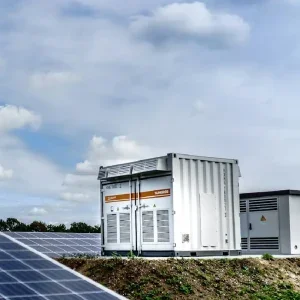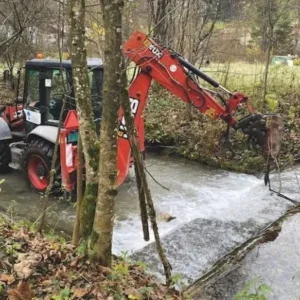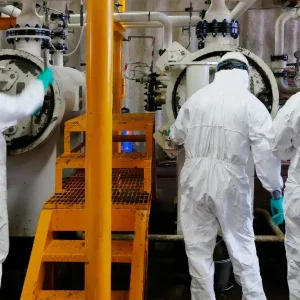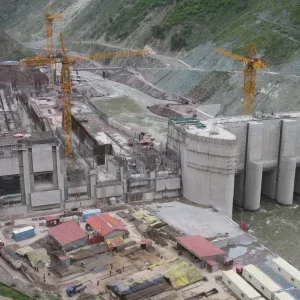
GE has introduced a new all-air-cooled version of its H class gas turbine technology. Called the HA (the A standing for air-cooled) the first machine off the production line, a 9HA (50 Hz) version, was as of late March on its way from GE’s gas turbine factory in Belfort, France, to its $185 million Greenville (South Carolina) gas turbine test bed, where, fitted with additional instrumentation, the gas turbine will undergo about 14 weeks of exhaustive full scale full load testing. The test cell is not grid connected, allowing in depth exploration of gas turbine behaviour at full load and beyond (equivalent to more than 8000 operating hours with a field prototype, with a wider operating envelope than would be encountered in the field).
The second HA machine off the production line at Belfort, also a 9HA, will be deployed at EDF’s Bouchain FlexEfficiency 50 combined cycle plant in France, which is currently under construction (and is GE’s lead FlexEfficiency 50 project), with commercial operation scheduled for 2016.
A number of other GE HA projects are in the pipeline, including an order for six 7HA (60 Hz) gas turbines from Chubu Electric in Japan and an order for a 9HA from another Japanese utility. There is also a "tremendous amount of bid activity", says Vic Abate, president and CEO, Power Generation Products, GE Power & Water.
In GE terminology, "H class" is essentially defined as a firing temperature in excess of 2600°F (about 1426°C) and up to about 2900°F (1600°C), with pressure ratio of 21:1, in conjunction with a four-stage power turbine (E class referring to firing temperatures of about 2000-2200°F and F class to 2300-2600°F).
GE commercially introduced its H class technology around ten years ago, the lead project being a 9H at Baglan Bay in the UK, followed by three more 9H units at Tepco’s Futtsu plant in Japan and two 7H gas turbines at the Inland Empire Energy Center in the USA.
But these GE H class gas turbines (which have now amassed around 200 000 operating hours, says GE) employed steam cooling of turbine components, including, remarkably, rotating parts. The new HA has greatly increased generating capacity (see graphs opposite) and can achieve combined cycle net efficiency of around 61.5% (ISO conditions) employing air cooling only (a technology strategy adopted by Siemens some years ago for its "H" class gas turbine and an option offered by Mitsubishi for its "G" and "J" series machines).
The ability to achieve such high efficiencies with just air cooling derives from advances in technology on a number of fronts, including blade aerodynamics (with concepts imported from aero engine practice), better understanding of heat transfer, improved design of hot gas path components to reduce temperature and stress gradients, more effective deployment of air by using more intricate cooling flows (eg employing several thousand tear-drop shaped holes where 500 circular holes might have been used in the past), improved thermal barrier coatings, and improvements derived from the wealth of operating experience amassed with the existing all-air-cooled gas turbine fleet.
While the current HA gas turbine does not employ any components made with additive manufacturing (aka 3D printing), the technique has been used to speed up the HA prototyping process and thereby accelerate introduction of the new machine. In the future, however, additive manufacturing is likely to be used to "print" ever more intricate parts (in particular, to achieve further improvements in internal blade cooling paths and cooling air management), This, combined with other advances, eg in aerodynamic 3D blading, use of ceramics, higher firing temperatures (with the possibility of 3000°F (about 1700°C) now under consideration), better sealing and further improved heat transfer, should enable 63% combined cycle efficiency to be achieved by the end of the decade.
And looking beyond that, Vic Abate believes that 65% combined cycle efficiency may be achievable with air cooling alone. Nevertheless he doesn’t think it is entirely the end of the road for steam cooling. "I wouldn’t say steam is done for ever…the physics of steam makes it still justified", and GE has built up a considerable body of knowledge in its application to gas turbine cooling, which could be revisited at some point in the future. However, steam cooling adds cost and complexity, and requires increased maintenance resources, it also reduces operational flexibility (not as important ten years ago when large combined cycle units were seen as predominantly baseload machines), so "the next chapter will be air", says Vic Abate.
The ratings of the new HA family of gas turbines are summarised in the tables (above and below). Both the 50 Hz and 60 Hz machines come in two versions, .01 and .02, the .02 version in each case having a higher generating capacity thanks to a bigger compressor. The 50 Hz gas turbines have 16 can annular combustion chambers, while the 60 Hz machines have 12. The highest rated machine of the new platform, the 9HA.02, at over 470 MW in simple cycle, "leads the industry in output" in terms of unit size, GE believes, and is certainly larger than the Siemens all-air-cooled H machine, the 50 Hz version of which is rated at about 375 MW in simple cycle (although another contender for world’s largest gas turbine must still be MHI’s M701J, also rated at about 470 MW).
Vic Abate says he "feels very good" about GE’s ability with the HA portfolio of power plants to be in a position to offer "blocks of power in sizes appropriate to market requirements," notably in the context of coal and nuclear retirements. The high efficiencies have also "caught the eye of customers in high-fuel-cost markets", while the machines in addition have the operational flexibility, fast start capability, ramping performance and turn down characteristics that power plant operators are increasingly insisting upon.
For the 9HA, GE summarises its flexibility qualities as follows: fast start capability – less than 30 minutes to full plant baseload, "a 25% improvement over comparable technologies"; turn down – "as low as 30% of baseload"; and ramp rate – "one of the best…in its class at nearly 60 MW/minute." For the 7HA: fast start – said to be in as little as "ten minutes from the start command"; turn down – as for the 9HA; and ramp rate – greater than 40 MW/minute, also described as one of best "in its class."
A further attraction of the new HA based power plants emphasised by Vic Abate is their increased modularisation and constructability, with, for example, significant reduction in the number of valves to be welded in on-site, and an overall reduction in construction time of around 25% compared with F class combined cycle plants.
Other key features of the HA include:
¦ 14-stage 3D aero compressor building on experience with 7F.05, which was validated at the Greenville test cell in 2011.
¦ Dry Low NOx (DLN) 2.6+AFS (Axial Fuel Staged) combustion system, which provides advanced fuel staging for enhanced steady state and transient performance.
¦ Emissions less than 25 ppm NOx and CO.
¦ A variable inlet guide vane (IGV) and three stages of variable stator vanes (VSVs) to manage compressor operability during start-up, control compressor airflow during turndown, and facilitate response to variations in ambient temperature and load.
¦ Advanced materials including TBC on the airfoil and use of single-crystal material in the hot gas path (building on single crystal experience with aero engines and aeroderivatives (LM2500, LM6000 and LMS100), as well as large frame 7F 3-series and 7F & 9F 5-series).
¦ Lean centre nozzle fuelling concept strategy enabling turndown to about 38% of baseload, allowing the combustor to operate at lower gas turbine loads while maintaining emissions compliance.
¦ Mark VIe* integrated control system (ICS) to connect power plant components with a single control architecture, facilitating comprehensive plant automation.
New naming system
With the launch of the HA, GE has also taken the welcome step of simplifying its gas turbine naming system, eliminating the previous FA and FB designations.






